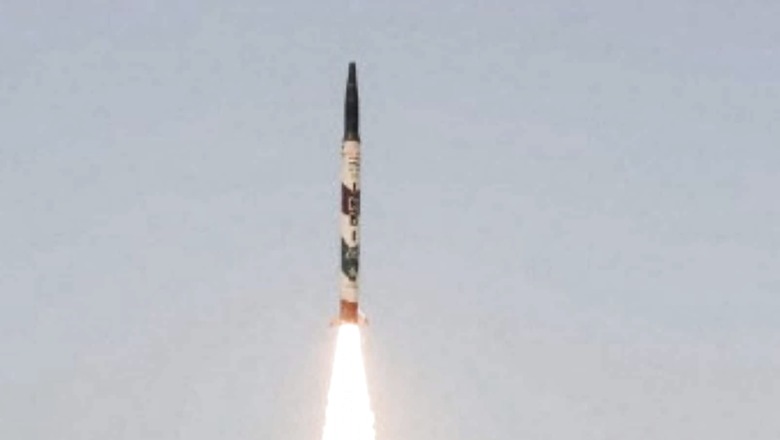
views
In a major boost to India’s military capabilities, the defence ministry on Wednesday announced successful test-firing of surface-to-surface ballistic missile Agni-5 whose range covers the Chinese mainland. The missile, which uses a three-stage solid-fuelled engine, is capable of striking targets at ranges up to 5,000 kilometres with a very high degree of accuracy, according to the defence ministry. The successful test of Agni-5 is in line with India’s stated policy to have credible minimum deterrence’ that underpins the commitment to No First Use’, the statement said.
Agni-5 is widely regarded as a strategic missile targeted at China as it can reach almost all parts of the Chinese mainland. People familiar with the development told PTI it was the first user trial of the missile which can bring the northernmost part of China under its striking range. India’s successful test-firing comes after China tested a nuclear-capable hypersonic missile in August.
Why Is The Test Significant?
Agni-V is India’s first ICBM — normally regarded as having a range of more than 5,000km — and has been under development for more than a decade. After its fifth test firing in January 2018, the Ministry of Defence had said that all the objectives for the test of the “long-range surface-to-surface ballistic missile… have been successfully met” and it “reaffirms the country’s indigenous missile capabilities and further strengthens our credible deterrence”.
However, although reports have said that the missile was to be inducted into the Armed forces after two more tests the same year — in June and December — making it seven successful tests in total, another test was lined up, which got delayed, however, due to the Covid-19 pandemic. The tests scheduled for September-end, was according to reports described as its “first user trials” was reported to assess the ability of the missile to carry multiple warheads, known in defence jargon as multiple independently targetable reentry vehicles (MIRV).
However, a report in Times Of India said that while India is working on MIRVs, the first tests of the technology won’t be held before two years. Reports say that a test on June 28 this year of the Agni P (for Prime), “a new generation advanced variant of Agni class of missiles” also involved a trial of MIRV capabilities, although it’s been suggested that that test had used “decoys” instead.
The successful test firing of the missile paves way for its induction into the Strategic Forces Command that takes care of India’s strategic assets, officials told PTI.
The Agni 5 project was aimed at enhancing India’s nuclear deterrence against China which has missiles like Dongfeng-41 having ranges between 12,000-15,000 km.
What Is MIRV?
MIRV capability allows a missile “to deliver multiple nuclear warheads to different targets” and was first developed by the US in the 1960s.
“In contrast to a traditional missile, which carries one warhead, MIRVs can carry multiple warheads,” says the US-based Centre for Arms Control and Non-Proliferation (CACNP).
The warheads on such missiles can be released “at different speeds and in different directions” with some known to be capable of hitting targets “as far as 1,500km apart”, CACNP says, adding that “although MIRVs were not initially intended to defeat ballistic missile defences, they are much more difficult to defend against than traditional missiles”.
CACNP says that “the development of MIRV technology is not easy” as it involves a “combination of large missiles, small warheads, accurate guidance, and a complex mechanism for releasing warheads sequentially during flight”.
In the neighbourhood, both China and Pakistan are said to possess MIRV-capable missiles.
What Is A Ballistic Missile?
According to the Nuclear Threat Initiative (NTI), India has the “capacity to deploy short-, medium-, and long-range ballistic missiles”. It says that the country “views its nuclear weapons and long-range power projection programmes as the key to maintaining strategic stability in the Asia-Pacific region”.
Ballistic missiles fly into outer space before returning on steep trajectories at higher speeds. Hypersonic weapons are difficult to defend against because they fly towards targets at lower altitudes but can achieve more than five times the speed of sound – or about 6,200 km per hour (3,850 mph).
It lists the Prithvi-II, Agni-I, Agni-II, Agni-III, and Agni-IV as “India’s fully operational land-based ballistic missiles”, noting that the country also has submarine-launched ballistic missiles (SLBMs).
Arms Control Association, another US-based organisation, says that ballistic missiles are “powered by rockets initially but then they follow an unpowered, free-falling trajectory towards their targets”. It notes that as of December 2017, there were 31 countries that had such missiles with only nine among them known or suspected to possess nuclear capabilities — China, France, India, Israel, North Korea, Pakistan, Russia, UK, US.
Why Is China Fuming?
China habitually uses its position as a permanent member of the UN Security Council (UNSC) to condemn missile tests by India. After reports emerged of plans for another test of the Agni V, Chinese foreign ministry spokesperson Zhao Lijian said at a press briefing that “maintaining peace, security and stability in South Asia meets the common interests of all, where China hopes that all parities would make constructive efforts”.
Touching specifically upon the topic of another missile test, he referred to the UNSC Resolution 1172 of 1998 — passed in the wake of nuclear tests held by India and Pakistan — which asks the two countries “immediately to stop their nuclear-weapon development programmes, to cease development of ballistic missiles capable of delivering nuclear weapons and any further production of fissile material for nuclear weapons”.
Zhou said that “as for whether India can develop ballistic missiles capable of delivering nuclear weapons, the UNSCR 1172 already has clear stipulations”.
China hitting out against Indian weapons development is nothing new and it would have noted that with a range of 5,000-plus kilometres, Agni V brings most of the Chinese mainland under its range, enhancing its strategic deterrence vis-a-vis Beijing.
The news of the test came after the US and UK announced the formation of a new strategic defence triad with Australia, called AUKUS, in the Indo-Pacific, promising the island nation nuclear submarines to patrol the waters where China has long tried to aggressively push its territorial claims.
Australia, along with Japan, India and the US has also revived the Quad grouping which, though not a military alliance, is seen as being geared towards containing China’s influence in the Indo-Pacific region.
India’s test-firing of the missile comes months after the Chinese military tested a nuclear-capable hypersonic missile in August. China launched a rocket carrying a hypersonic glide vehicle that flew through low-orbit space, circling the globe before cruising towards its target, which it missed by about two dozen miles.
(With inputs from agencies)
Read all the Latest News , Breaking News and IPL 2022 Live Updates here.


















Comments
0 comment